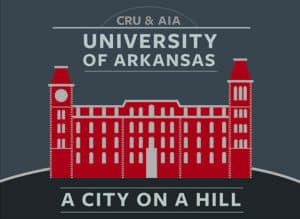
This is the part 5 in a series of posts summarizing key findings from researching 17 of Cru’s Top Sending Campuses in the nation.
See the Intro for a full list of all the campuses profiled (and links to each).
It’s one thing to take all of this in. To hear what these Top Sending Schools are doing and think, “Well, that’s great. Good for them.”
The next step is to consider: “What does our campus need to implement from these Top Sending Schools?”
I thought it might be helpful to share with you what we have implemented on our campus at the University of Arkansas, since I’ve talked to these schools over the last couple years.
We’re taking baby steps toward sending. We’re learning it takes years, not months, to correct our course. I would guess it will take about 5 years – to see a freshmen class raised up under a culture of sending.
“You are changing the culture of your movement not just getting people to sign up. This will take time, intentionality and prayer.”
What we’ve implemented from the Top Sending Campuses (in order of impact):
- If you’re not sending it’s probably because you as the director don’t really believe in sending
- This was my biggest realization.
- I have had very few game-changing epiphanies in my time as a director. I can only think of three:
- Discovering Movement Building – reading this little article gave me incredible clarity on what it looks like for me to succeed in my job in college ministry.
- Discovering the Secret of Success for Fund Raising Dinners
- And this: If you’re not sending it’s probably because you as the director don’t really believe in sending
-
- If you would have asked me a few years ago why we don’t send more, I would have listed out 10 things students need to be doing: we need to get more students on Summer Mission, students need to care more about the world, etc, etc
- I can distinctly remember sitting down last fall with Brian White, Cru MTL (Missional Team Leader) at Texas A&M. I asked Brian: “How are y’all so good at recruiting?” He immediately and politely corrected me: “We don’t recruit. Sending is who we are.”
- It’s not a matter of semantics. For Texas A&M it’s not recruiting. It’s in their DNA. It’s the air they breathe as a staff team and movement.
- More specifically, it’s Brian’s DNA. Brian eats/drinks/sleeps sending to the World.
- I just sat there and got schooled for the next hour in what it looks like for an MTL to bleed for the world. Brian lives to send to the world.
- Realizing that sending starts with the MTL was a game changer.
- “As the leader, as the mouthpiece, you need to be telling the stories and leading from experience.” – Brian White
- It’s why I’m sitting in a hotel in East Asia as I write this. Because if I don’t go, I won’t bleed for the world. I can’t bleed for a country I’ve never been to. So I’m here seeing what God is doing. Asking God to break my heart for this country. Meeting with the national staff to hear what their vision for their country is. Going on campus to do ministry.
- That is by far the most impactful takeaway for me personally, and hopefully for our movement: I as the MTL need to go and personally own sending
- “Our movements always reflect our leaders’ passions. If I’m asking how do I change the movement, I need to ask, what do I need to change? I need to ask — how passionate am I about it? What am I teaching? What am I talking about? Am I living this out? Are we highlighting it?” – Bacho, MTL at Ohio State
- A corollary: My co-MTL and I need to be the ones challenging students to join with us:
- “I had to learn as an MTL: My words carry a lot of weight — I’m looking people in the eye and I’m saying: ‘I’d really like you to be on our team’”
- Our family is committing to going overseas on Summer Mission every three years
- It’s an extension of the previous point, but our family is planning on going on Summer Mission next summer to East Asia.
- It costs a small fortune for my family to go anywhere. We have 5 kids.
 But in talking to Brian White and his wife Erin (Cru leaders at A&M), they would say that one of THE keys to them sending so many students into full time ministry has been their family going overseas every three years (and they have 4 kids – pictured (a long time ago!) to the right).
But in talking to Brian White and his wife Erin (Cru leaders at A&M), they would say that one of THE keys to them sending so many students into full time ministry has been their family going overseas every three years (and they have 4 kids – pictured (a long time ago!) to the right).- My oldest kid is 13 and we have NEVER taken them overseas on a Cru Summer Mission. I honestly didn’t feel like it was a good investment of God’s money to spend close to $30,000 for 1 of us to work full time on campus (my wife is working full time with Cru but would spend 95% of her time keeping up with 5 kids!). So we’ve never done it. I’ve taken a couple vision trips on my own, but our family has never gone.
- But as I sat down with Brian and Erin White, I was convinced. They showed me a picture of a Summer team they took to East Asia 5 years ago. Something like 13 of the 15 students are interning or on staff with Cru now. That’s not a bad batting average. And both Erin and Brian pointed to the students really connecting with their family and coming back to College Station and continuing to be close to their family.
- Why every three years? Not exactly sure! We’re just following the White’s wisdom here! I would guess because: It IS expensive and because there are other needs some summers (MPD, seminary, sabbatical)
- Staff owning it
- Again, this is an extension of the first point.
- We’re not sending because our staff 1) Aren’t going and 2) Aren’t passionate about sending
- “The main mouthpieces of the movement need to be speaking of the partnership from first hand experience. Vision trips or summer projects every few years are great ways to keep things fresh for those who are casting vision.” – Texas A&M
- So a few things we’re implementing as a team:
- We want every staff/intern to go to one of our partnerships in their first 2 years on the team (either on a Vision Trip or Summer Mission)
- Our staff are actively seeking to lead our Summer Missions partnerships (both internationally and stateside)
- Previously, we were pretty hands off with our staff’s summers. We were like the book of Judges: “everyone did what was right in their own eyes”.
- But we want to set a norm on our team that most staff will go on one of our three partnerships EVERY summer:
- East Asia
- Ethiopia
- San Diego
- “Come with me” is far more powerful than “you should go”
- We’ve noticed a HUGE difference in the number of students who will go if we have our staff or key students leading a project (vs when they are being led by other campuses’ staff). HUGE.
- We are asking our staff to decide by August where they will be going for the Summer and Spring Break. So the minute they step on campus in the fall they are planting seeds with students- “Hey, what are you doing this summer? You should totally come with me to Ethiopia this summer!”
- Part of this has been lobbying our region to move up their Summer placement to August
- Previously, our staff would find out in November where they are going
- Being proactive to select summer and STINT leaders for the coming year
- They are the most important people to get on board (again, preferably by August)
- Because they will assemble their team
 Govember –we have done this for two years now and I think it has really helped create a sending culture. – via Wisconsin
Govember –we have done this for two years now and I think it has really helped create a sending culture. – via Wisconsin- We continue to really push Summer Missions and have started to really push Vision Trips
- “Summer Missions are the lead measure for full time staff” — Wisconsin
- “There’s a good chance if students go on Spring Break overseas, then STINT will be on their radar”
- Junior Recruiting Dinner – via Virginia Tech
- “We used to do most of our recruiting during student’s senior years. But we kept finding that we were too late. Students had already accepted jobs. For most of our students, the summer after the junior year internship is the job interview.
- So we started doing a Junior Recruiting Dinner — the spring of their junior year.”
- This spring we did two small dinners (about 6-8 students at each). We’ll likely do another in the fall to catch the students who were not able to make it to one of those spring dinners
- We’re actively pursuing a Foundational Sending Class.
- We made a little progress this year – we have 8 STINT’ers going and 2 interns staying. But next year we hope to have at least 6 on both of our STINT teams, and 6 interns.
- We try to help students connect relationally with our staff team
- We invite our Student Staff (8 juniors/seniors) to our weekly staff meeting as well as any staff socials
- Because: “Healthy teams are attractive to students” and “It snowballs when your team is an attractive team to be on and students get to be around that enough and think ‘I want to be a part of that’”
- Send first and send your best
- “Be generous. The needs of the world are greater than on our US campuses. Challenge and send your best and brightest to the world…God will provide and give back.” “I would rather send a solid team than have a big team here.” – Texas A&M
- This is really hard. But we’re trying. And I feel like our attitudes on our staff team are changing to “we need more laborers on our campus!” to “let’s just send as many as possible to the world!”
 Vision for the world
Vision for the world
- We’ve shifted from just “let’s reach all 26,000” students on this campus to:
- Let’s reach The Hill so we can be a City on a Hill to be a light to the nations (the U of A is affectionately called “the Hill”)
- We’ve shifted from just “let’s reach all 26,000” students on this campus to:
- We’re pushing the Perspectives on the World Christian Movement course.
- We had 21 students take this intensive World Vision course this spring. It will be interesting to see how many of those students go to the world after graduating.
- We’ve started tracking who we’re sending/have sent over the years – via Wisconsin